Seed is the specialized part of a plant that produces a new plant. It contains an embryo (partly developed plant) that consists of an immature root and stem. A seed also has a supply of stored food and a protective covering.

Seeds are produced by approximately 250,000 kinds of plants. Flowering plants make up the largest group of seed-producing plants. These plants, which botanists call angiosperms, include the vast majority of trees, shrubs, and soft-stemmed plants. Seeds are also produced by about 800 kinds of trees and shrubs called gymnosperms. Most gymnosperms develop cones.
The seeds of different kinds of plants vary greatly in size. The double coconut tree produces the largest seed, which weighs up to 50 pounds (23 kilograms). On the other hand, orchid seeds are so tiny that 800,000 of them weigh no more than an ounce (28 grams). The size of a seed has no relationship to the size of the plant that develops from it. For example, the giant redwood tree grows from a seed only 1/16 inch (1.6 millimeters) long.
The number of seeds produced by an individual plant varies according to the size of the seeds. A coconut tree has only a few large seeds, but an orchid or pigweed plant produces millions of tiny ones.
Kinds of seeds
Seeds develop from structures called ovules, which are in the flowers or on the cones of a plant. Botanists divide seeds into two main groups, enclosed seeds and naked seeds.

Enclosed seeds are produced by angiosperms. Their ovules are enclosed by an ovary, a structure within the flower. As the seed ripens, the ovary enlarges and forms a fruit, which provides some protection for the developing seed. In some plants, the ovaries develop into fleshy fruits, such as apples and peaches. Other plants, such as peas and poppies, have dry fruits that form pods or capsules. In grain plants, such as corn and wheat, the ovary and ovule join together, forming a hard kernel.
Naked seeds are produced by gymnosperms. The most common type of gymnosperm are the conifers. Conifers produce ovules on the upper surface of the scales that form their cones. Gymnosperms have no ovaries, and so their seeds are not enclosed during development. However, the scales of conifer cones close up together when the seeds are ripening and provide some protection for the seeds.
The parts of a seed
Seeds consist of three parts: (1) the embryo, (2) the food storage tissue, and (3) the seed coat. 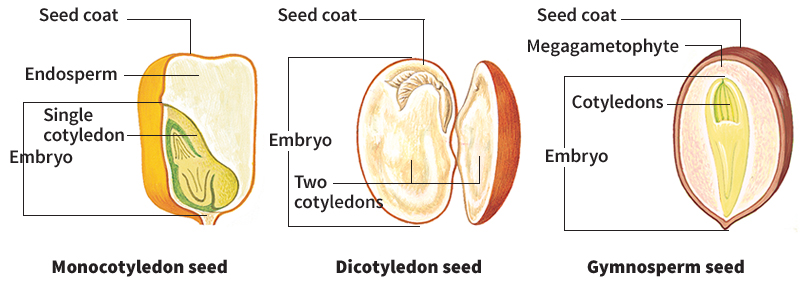
The embryo is the part of the seed from which the mature plant develops. It contains the parts that develop into the primary root, the first root to grow; the stem; and the first leaves of the new plant. The embryo also has one or more specialized leaflike structures called cotyledons. Angiosperms have either one or two cotyledons. Those with one cotyledon are called monocotyledons or monocots. Angiosperms with two cotyledons are called dicotyledons or dicots. Gymnosperms have from two to eight cotyledons.
The cotyledons absorb and digest food from the food storage tissue of the seed. In angiosperm seeds, this tissue is called the endosperm. The cotyledons of some dicotyledon seeds quickly absorb all the food in the endosperm. The cotyledons then store the food that the embryo needs for growth. In gymnosperm seeds, food is stored in tissue called the megagametophyte.
The seed coat covers the embryo and food storage tissue and protects them from injury, insects, and loss of water. Seed coats range from thin, delicate layers of tissue to thick, tough coverings.
How seeds develop
Seed formation results from sexual reproduction, in which a sperm (male sex cell) unites with an egg (female sex cell). The production of sperm and egg cells in seed plants involves a number of complicated steps. First, the male and female reproductive organs of the plant produce microscopic cells called spores. The spores grow into gametophytes, which are actually tiny plants that live within the reproductive organs of the parent plant. The gametophytes produce the sperm and egg cells.
Seed development in angiosperms.
The reproductive organs of an angiosperm are in its flowers. The female reproductive organ is called the pistil. The ovary, which contains one or more ovules, forms the round base of the pistil. A tube called the style extends up from the ovary and ends in a flat tip called a stigma. The male reproductive organ is called the stamen. The stamen has an enlarged tip called the anther.
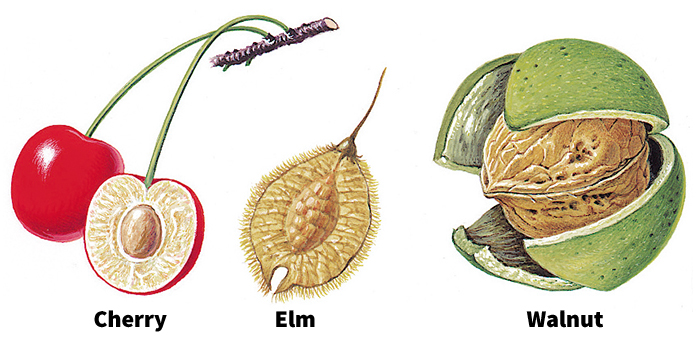
The development of a seed begins with cell divisions in the ovule and in the anther. These cell divisions result in the production of spores. In most plants, one spore in each ovule grows into a microscopic female plant, the megagametophyte. This tiny female plant produces one egg cell. In the anther, the spores grow into microscopic male plants called microgametophytes, or pollen grains. Each pollen grain produces two sperm cells.
For fertilization to occur, a pollen grain must be transferred from the anther to the pistil. This transfer is called pollination. Pollen grains are carried from the anther to the stigma by insects or other animals or by the wind. After the pollen reaches the stigma, the grain produces a long, slender pollen tube. This tube grows down through the style and into the ovule. The two sperm cells travel down the tube to the ovule. There, one sperm cell fertilizes the egg cell, and an embryo starts to form. The other sperm cell joins with two bodies called the polar nuclei, and the endosperm begins to develop. After fertilization, the outer layers of the ovule develop into the seed coat.
Seed development in gymnosperms.
The reproductive organs of gymnosperms take many forms. In conifers, these organs are in cones. A conifer has two kinds of cones, female seed cones and male pollen cones. Each scale of a seed cone has two ovules on its upper surface. Cell divisions occur in the ovules, and each ovule produces a spore that grows into a megagametophyte. This tiny female plant produces egg cells. The scales of a pollen cone have structures that undergo cell divisions and produce spores. These spores develop into pollen grains.
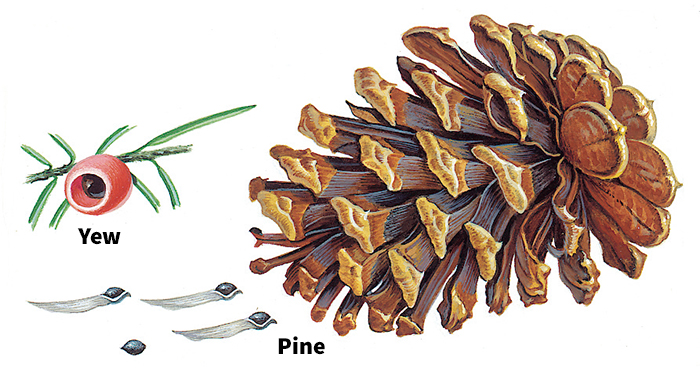
The wind carries pollen grains from the pollen cones to the seed cones. The pollen gets stuck to a sticky substance near the ovules and begins to grow pollen tubes. Each pollen grain has two sperm cells. After the pollen reaches an ovule, one of the sperm cells fertilizes the egg cell, forming the embryo. The other sperm cell disintegrates. The megagametophyte becomes the food storage tissue of the seed. The seed coat develops from the outer layers of the ovule.
How seeds are spread
After seeds have matured, they go through a state of reduced activity called dormancy, when they do not sprout. During dormancy, seeds are dispersed (scattered) from the parent plant. Seed dispersal increases the chances that some of the seeds will fall in areas suitable for growth.
Some kinds of angiosperm seeds are dispersed while still inside the fruit. The fruit later splits apart or disintegrates and releases the seeds. In other flowering plants, the seeds are released from the fruit before dispersal.
Seeds are dispersed in various ways. In some cases, the fruit drops to the ground and the seeds sprout near the parent plant. However, most seeds have features that enable them to be carried long distances by the wind, animals, water, or people.
Many kinds of seeds are especially suited for dispersal by the wind. For example, some fruits and seeds have winglike structures that keep them aloft. They include the fruits of maple trees and the seeds of ash and elm trees. The wind also carries fruits and seeds that have fluffy coverings, such as dandelion fruits and cottonwood and willow seeds.
Animals also play an important role in seed dispersal. Birds and other animals eat brightly colored fruits. However, the seeds are not digested. They are deposited as part of the animal’s body waste–sometimes many miles from the parent plant. Animals also disperse seeds by carrying fruits and seeds on their body. The fruits of the beggarstick, needlegrass, and some other plants have spines and barbs that stick to the fur of an animal. Seeds with sticky coats are also transported by sticking to an animal’s body.
The seeds of most water plants are dispersed by floating on rivers, streams, and oceans. Coconut trees and some other land plants have seeds that can float. This type of seed is often transported by water.
Some kinds of seeds are dispersed by an explosive action that occurs when the fruit dries and splits apart. The splitting of a fruit can scatter seeds for several feet. The seeds of geraniums, milkweeds, and touch-me-nots are dispersed in this way.
People have brought along supplies of the seeds of various crop plants and ornamental plants when migrating to many parts of the world. People also aid seed dispersal unintentionally by carrying seeds on their shoes and other articles of clothing.
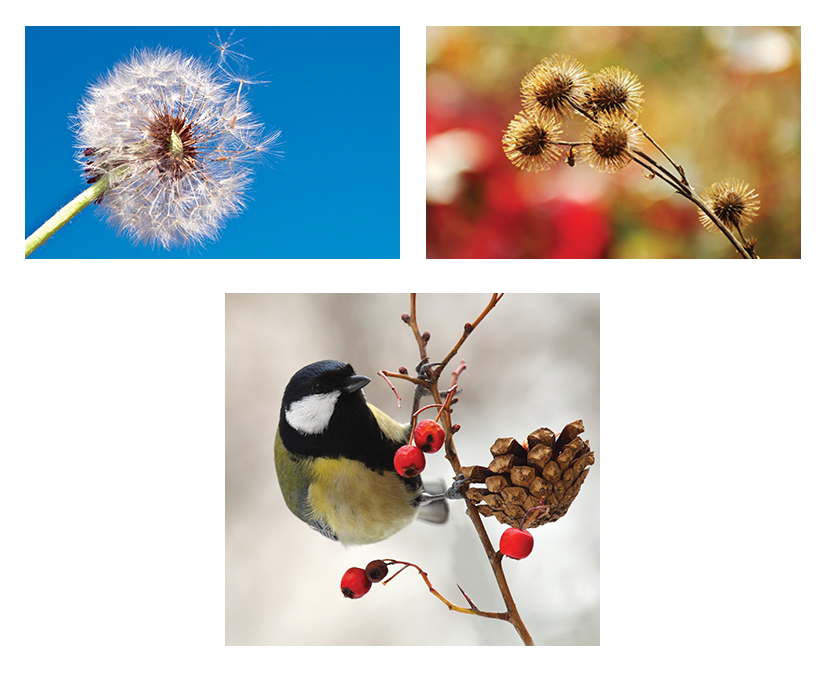
How seeds sprout
Ripe seeds sprout through a process called germination. After being dispersed, most seeds remain dormant instead of germinating immediately. Dormancy prevents seeds from sprouting when conditions are not favorable for growth. For example, many seeds remain dormant during the cold winter months and germinate after temperatures start to rise in spring.
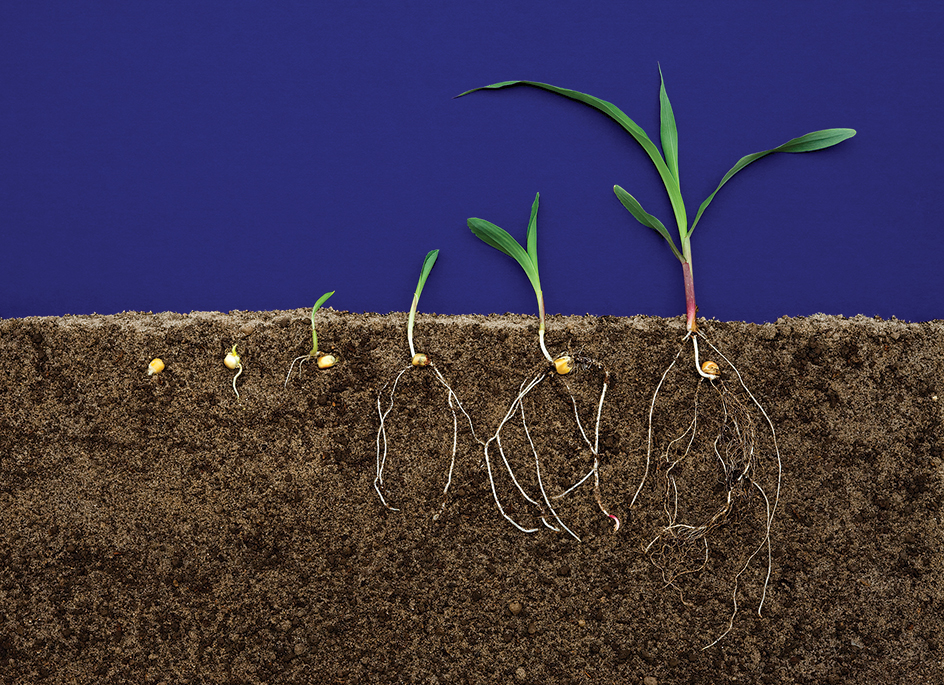
Seeds can remain dormant for varying periods and still be viable—that is, able to germinate under proper conditions. In general, the period of viability ranges from a few weeks to 50 years. In one case, however, scientists found that dormant 10,000-year-old lotus seeds could germinate when conditions were favorable for growth.
Conditions required for seed germination include abundant water, an adequate supply of oxygen, and proper temperatures. When a seed begins to germinate, it absorbs large amounts of water. The water causes many chemical changes inside the seed. It also causes the seed’s internal tissues to swell and break through the seed coat. Water also softens the seed coat so that it breaks apart more easily.
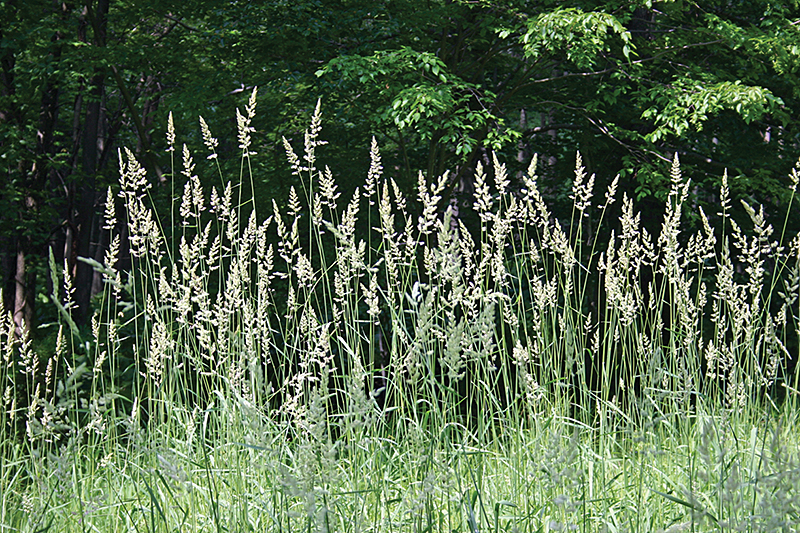
Germinating seeds require an adequate amount of oxygen to support their high rate of respiration. Respiration is the taking in of oxygen and the giving off of carbon dioxide. This process enables a germinating seed to burn food and thus produce energy for growth.
Temperature requirements for germination vary. Species that germinate in summer require higher temperatures than those that germinate in spring. Many seeds require a cold period before they can germinate.
Some kinds of seeds need a certain amount of daylight to germinate. Many seeds will sprout only during the spring, when the number of daylight hours increases. Others sprout only in late summer or early fall, as days shorten.
After the seed coat breaks and germination starts, the part of the embryo below the cotyledon begins to grow down into the soil. This part, called the hypocotyl, develops into the primary root. The developing roots anchor the seedling and absorb minerals and water that the embryo needs for further growth. The upper part of the embryo, called the epicotyl, has a bud called a plumule at its tip. The epicotyl grows longer and pushes the plumule upward above the ground. The plumule then produces the first leaves.
In the seeds of gymnosperms and certain dicots, the cotyledons are also carried above the ground. They remain on the plant until it has formed new leaves that can manufacture food. The cotyledons of monocots and some other dicots remain below the ground as the plumule emerges.
How people use seeds
Seeds serve as a major source of food for millions of people throughout the world. The seeds of cereal grains, including corn, oats, rice, and wheat, are used in making many food products, such as bread, breakfast cereals, and flour. The seeds of plants called legumes, which include beans, peas, and peanuts, are also important sources of nourishment.
Vegetable oils used in cooking are obtained from the seeds of such plants as corn, peanuts, soybeans, and sunflowers. In addition, manufacturers use these oils in making margarine, salad oil, and shortening. Such flavorings and spices as dill, mustard, and pepper are obtained from seeds, and seeds are used in producing beer, coffee, cocoa, and other beverages.
Seeds are also used in the manufacture of many nonfood products. Seed oils are a major ingredient in deter-
gents, soaps, paints, and varnishes. Cornstarch from the endosperm of the corn seed is used in making adhesives, explosives, and other products. Most livestock feed includes the seeds of corn, oats, and other grains. Some seeds, including those of the belladonna and castor-oil plants, provide substances used in medicines.
